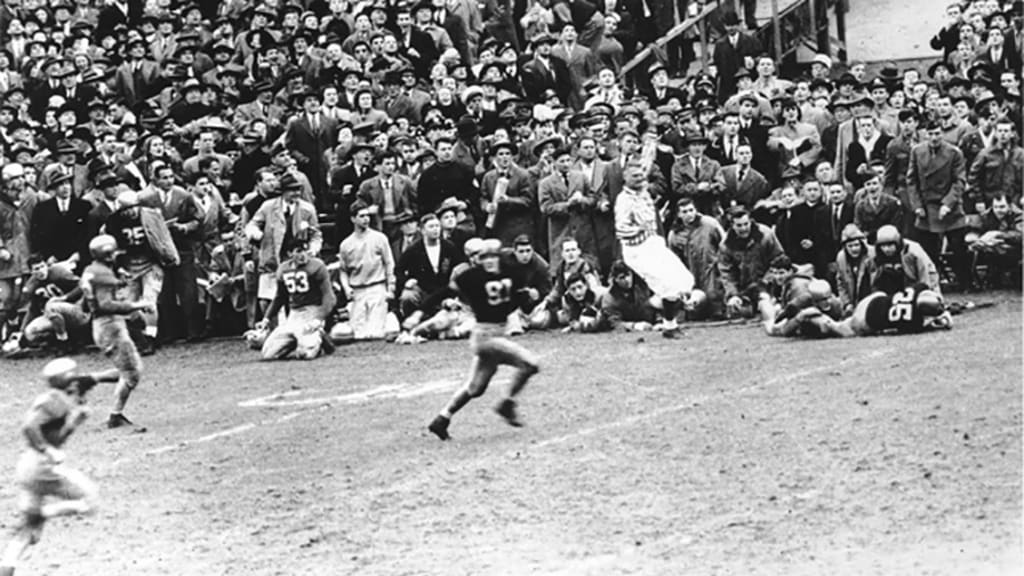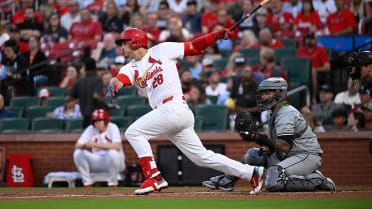Home of Champions
Tradition has followed the Fighting Irish from South Bend to the South Bronx

A yellow sign hangs from the bottom of a narrow staircase. It is mounted on one of many yellow brick walls that support the 80-year-old structure. The message symbolizes the tradition of this institution. It reads: "Play Like A Champion Today."
This is the home locker room at Notre Dame Stadium in South Bend, Indiana, a tiny town in the middle of nowhere.
That tradition was on display at Yankee Stadium on Nov. 20, 2010, when the Fighting Irish renewed an old rivalry with the Army Black Knights in the first football game in the Yankees' new home.
Notre Dame is built on national championships, and the team has won 11, the first coming in 1924 and the last coming in 1988. Its folklore encompasses 49 members of the College Football Hall of Fame, some of whom have transcended the sport.
"Guys like Knute Rockne, Paul Hornung and Jim Crowley are cultural icons, and that is what distinguishes them from so many other sports heroes," said Notre Dame athletic director Jack Swarbrick. "Those guys are still larger than life."
The Fighting Irish have won more than 300 games at Notre Dame Stadium, yet the Bronx was the site of its fair share of Notre Dame's greatest moments.
In 1925, one year removed from its first national championship, Notre Dame took on Army at Yankee Stadium. The Fighting Irish were shut out 27-0, but the exposure that was gained by playing the Cadets in a part of the country that was unfamiliar with their program paid long-lasting dividends.
"Our tradition really began in Yankee Stadium," said Father Theodore Hesburgh, who served as the university's president from 1952 to 1987. "We took a train from South Bend to play there. We only had 16 players on our team. We were this small team that came to New York to play a perennial powerhouse. That's how we got to be called the 'Fighting Irish.' That game catapulted Notre Dame into national prominence."
Notre Dame avenged the loss the next season, defeating Army 7-0 behind Rockne's hard-nosed team.
On Nov. 10, 1928, Rockne orchestrated his defining moment from the bowels of a chilly Yankee Stadium. Notre Dame and Army were locked in a scoreless tie at halftime when Rockne delivered his most famous speech.
George Gipp rushed for 2,341 yards and passed for 1,769 yards at Notre Dame before passing away in 1920 at the age of 25. In perfect sync with the drama of the day, Rockne told his players that, while on his deathbed, Gipp requested that Notre Dame rally for a big win in his memory.
"The last thing he said to me was, 'Rock, when the team is up against it and the breaks are beating the boys, tell them to go out there with all they've got and win just one for the Gipper,'" the coach told his team.
While historians dispute whether Gipp actually uttered those words to Rockne, the speech worked. The underdog Fighting Irish beat Army 12-6.
"Knute Rockne's speech tells you everything you need to know about attitude," former Notre Dame coach Lou Holtz said. "It made those players understand what their purpose was. That pep talk gave all of us motivation, not just the people who were in the locker room that day."
Notre Dame's good fortune at Yankee Stadium continued into the mid-1940s as the Irish defeated Army in 11 out of the next 14 contests. But Army turned the tide in 1944, defeating Notre Dame 59-0 behind the running attack of Doc Blanchard and Glenn Davis. Army trounced Notre Dame again in 1945 - this time by a score of 48-0 - en route to a second consecutive national championship.
"Those games were the Super Bowl of that era," said Joe Steffy, who played guard for Army in the 1940s and who was inducted into the College Football Hall of Fame in 1987. "There was no bigger rivalry in sports at that time."
On Nov. 9, 1946, with Army riding a 25-game winning streak, the Black Knights took on an undefeated Notre Dame team at Yankee Stadium in what was dubbed the "Game of the Century." Tickets for the game, which were priced at $1, were being scalped for as much as $250 apiece on gameday.
The Fighting Irish came into the game with a disadvantage.
"On the Wednesday before the game, we were doing a pass defense drill, and I stepped into a hole and turned my ankle badly," said Johnny Lujack, the team's All-American quarterback and defensive back. "We practiced at Bear Mountain that Friday, and I was still in a lot of pain. I didn't know if I would be able to play in very much of that game."
Not only did Lujack play in the game, but he made the play of the game. With the teams locked in a scoreless third-quarter tie, Blanchard broke free at midfield, and Lujack was the only defender between the halfback and the end zone.
"I was able to make a shoestring tackle," Lujack said. "Doc said that if his ankle had been better, I wouldn't have gotten near him. I say that if my ankle had been better, I would have caught him earlier."
That was the closest either team came to putting points on the board in the game, which featured a Heisman Trophy winner in Blanchard (1945) and three eventual Heisman winners in Davis (1946), Lujack (1947) and Notre Dame's Leon Hart (1949).
"That was the most fiercely fought game I ever played in," Steffy said. "The teams didn't have very many players back then, so we were in the game for almost every play."
After the scoreless tie, both teams held their positions in The Associated Press rankings until the final week of the season, when Army barely beat unranked Navy, who Notre Dame had defeated 28-0 earlier that year. The Irish defeated 16th-ranked University of Southern California 26-6 in their final game. That victory propelled Notre Dame (8-0-1) over Army (9-0-1) in the polls and made the Irish national champions.
Scheduling conflicts and other factors moved the Army-Notre Dame rivalry away from Yankee Stadium until 1969, when Notre Dame thrashed Army 45-0 in the last contest between the two schools in The House That Ruth Built.
Notre Dame edged Army in all-time Yankee Stadium play, capturing 14 wins while only losing on five occasions. The series also yielded three ties.
In 1963, Notre Dame lost to Syracuse in one of only two games that the Irish played at the Stadium against other teams.
Even though that matchup didn't have the luster of Notre Dame's previous Stadium tilts, it was still a proud day for the players who participated in that game.
"I grew up about 15 miles from Yankee Stadium, and my dad used to take me there when I was a young kid," said Tom Longo, who played quarterback for the Irish. "The first time I walked onto the field, I was just thinking about the guys who had played on that same field, like Babe Ruth, Lou Gehrig and Joe DiMaggio."
Time has a way of changing everything, but the thrill of stepping on the field that Derek Jeter and Mariano Rivera have called home will have the same lasting impact for the this year's New Era Pinstripe Bowl participants.
For more New Era Pinstripe Bowl coverage, visit PinstripeBowl.com.



